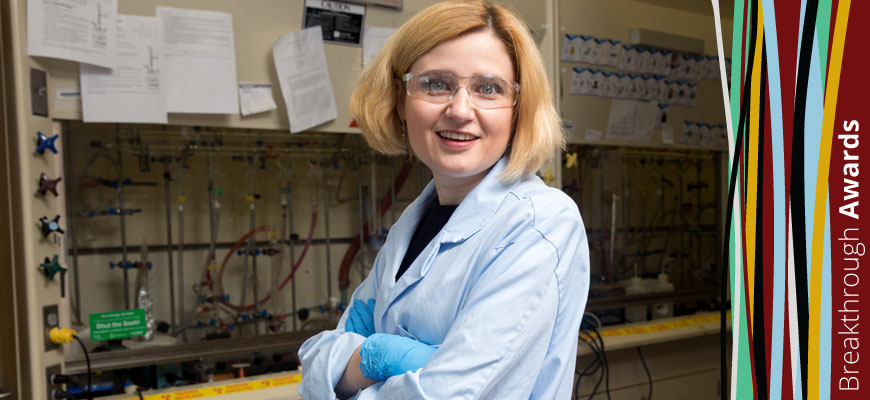
Super sponges
Chemistry researcher Natalia Shustova develops smart sponges that convert light to energy and more
Posted on: February 24, 2017; Updated on: February 24, 2017
By Chris Horn, chorn@mailbox.sc.edu, 803-777-3687
Natalia Shustova calls them smart sponges, but the versatile qualities of the material she and her research team have made begs for a more potent name — super sponges, perhaps?
The inorganic chemist and her team have worked on hybrid, metal-organic materials that are highly porous and have extraordinarily large surface areas. The internal surface area of one gram of the Shustova’s smart sponge material equals the surface area of a football field. But that only describes the smart sponge’s physical characteristics.
“The sponge can capture light, convert it to energy and then catalyze a reaction,” Shustova says. “With this, we could potentially use solar energy to convert carbon dioxide to something useful — so not CO2 sequestration but CO2 utilization.”
Shustova is also part of a multi-university research project led by Carolina chemistry professor Hanno zur Loye that’s focused on long-term storage solutions for radioactive waste. Her sponge material will be tested as an option for long-term storage of uranium and thorium, two important components of the spent nuclear fuel.
We can tell students, ‘You can be a successful woman in science and have a work/life balance.’ But until they see it, they won’t believe you.
Natalia Shustova
Shustova’s sponges have made the covers of two high-profile chemistry journals, and her innovative work has earned a National Science Foundation Faculty Early Career Development Award. Earlier this spring, she was named a Cottrell Scholar and Sloan Research Fellow, two prestigious awards that recognize outstanding teacher-scholars. She has published nearly 60 peer-reviewed articles, including 11 papers about her independent research at Carolina.
The chemistry scientist hasn’t spent all of her time in the laboratory, however. Not long after joining the faculty in 2013, Shustova launched the Carolina Women-in-Science Support Network, now supported by an EPSCoR IdeA grant, to mentor female students in the STEM disciplines at institutions of higher learning across the state.
“Everyone knows there’s a gender gap, and it’s a big one,” she says. “I think what’s been missing is a role model. We can tell students, ‘You can be a successful woman in science and have a work/life balance.’ But until they see it, they won’t believe you.”
Along with successful women in industry and academia who speak at Women-in-Science workshops, Shustova presents herself as someone who has demonstrated success in several areas — teaching, research and raising a family.